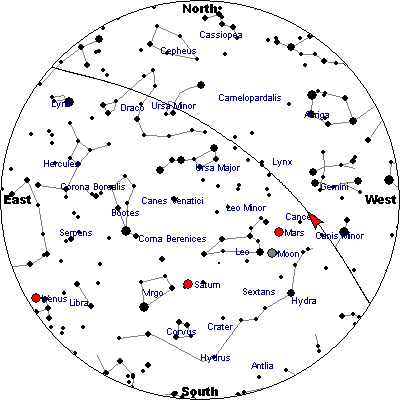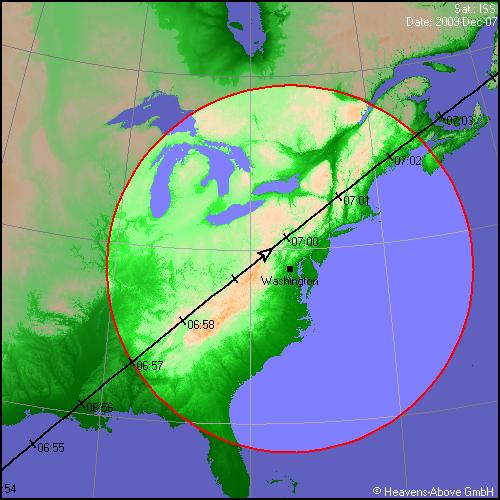| How to View the
International Space Station in the Night Sky You can see the International Space Station and other Earth satellites in the night sky. No telescope or binoculars are needed. You only need to know where and when to look. The space station looks like a bright, fast-flying airplane, but without any blinking or colored lights. It can be as bright as the planet Venus and is easily visible, even in lit-up city skies. The Space Shuttle is also easily visible. During most of the night, satellites fly in the dark and are therefore invisible against the dark sky. During the day, the bright blue sky obscures the view any satellite. However, for an hour or two after sunset and and hour or two before sunrise, the sky is dark, but high-flying satellites are lit up by the Sun and visible against the dark night sky. To find out where and when to look for the International Space Station (ISS) and other satellites, see Chris Peat's Heavens Above web page. The home page shows the current position of the ISS over the earth in a picture like the following:
To determine when there are viewing opportunities, you need to enter your current location. From the Heavens Above home page, under Configuration, click "select from database," then select your country name and enter your city name. Then select your city from the list of matching names. This takes you back to the home page with your city name, latitude, and longitude shown under Configuration. After you enter your location, under Satellites, click ISS. This presents a table showing the time and location of each viewing opportunity over the next two weeks. For example:  The table shows the viewing date, the maximum brightness magnitude, the starting time, the maximum-altitude time (when the ISS is the highest above the horizon), and the ending time. The listed times are for your local time zone, including daylight savings time, if applicable. These are 24-hour clock times, so 17:03 means 5:03 PM and 6:14 means 6:14 AM. The table also shows you where to look: W for west, SE for southeast, and so on. The magnitude indicates the relative brightness, with smaller or more negative numbers representing greater brightness. As a measure of comparison, the brightest planet, Venus, has a magnitude of -4.4 and the brightest star, Sirius, has a magnitude of -1.4. The North Star, Polaris, has a magnitude of 2.0. Click the date in the table, and you get a star map showing the path of the ISS across the sky for that viewing opportunity:  Click the Ground Track link, and you get a map showing the path of the ISS over the ground for the viewing opportunity, with the local times marked along the route:  You can see the ISS only when it is inside the red circle. In this example, the ISS rises above the horizon at 6:57 AM, passes nearly overhead at 7:00 AM, and then sets on the horizon just after 7:02 AM. A great time to view the ISS is shortly before docking with the space shuttle, or after undocking. If you're lucky, you can see both spacecraft at the same time with a slight separation in the sky. Chris Peat's Heavens Above web site is the best source for information about viewing the International Space Station and other satellites, even better than NASA's own SkyWatch web page. You can help support the Heavens Above web site by viewing any sponsor ads there that interest you. |
